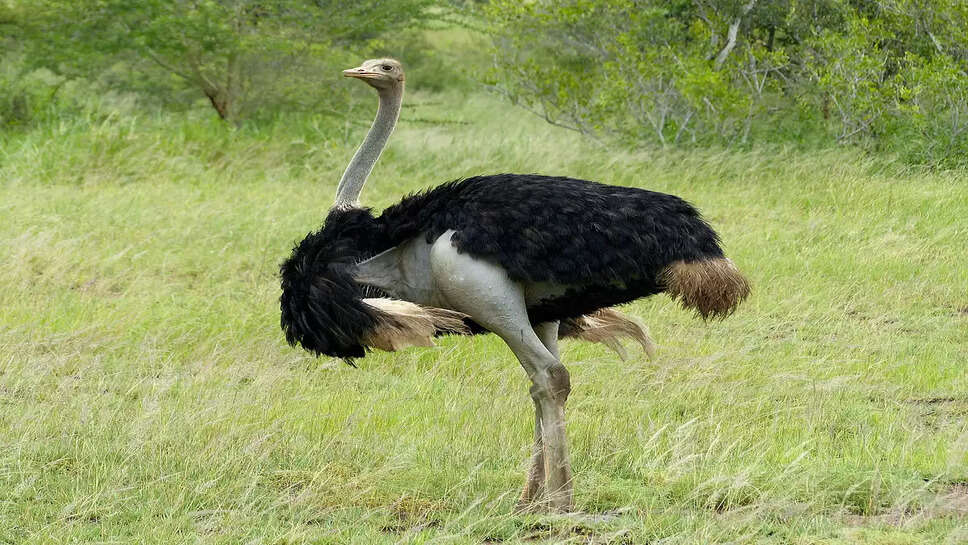Grounded by Design: The Ostrich’s Journey from Flight to Speed

The ostrich is one of nature's most fascinating contradictions — a bird that cannot fly but is unmatched in speed on land. Towering over most animals in its native habitat and sprinting faster than most predators, the ostrich is a remarkable example of evolutionary specialization. While its massive wings and feathered body suggest an aerial heritage, everything about the ostrich today screams terrestrial excellence. It has traded flight for speed, agility, and survival on the ground.
In this article, we explore how and why the ostrich is built for land and not for flight, analyzing its anatomy, behavior, and the evolutionary path that shaped this giant flightless bird.
A Flightless Giant
The ostrich (Struthio camelus) is the largest living bird on the planet. Adult males can reach up to 9 feet in height and weigh more than 150 kilograms. With such mass and bulk, taking to the skies is physically impossible. Flying demands lightweight frames, strong breast muscles, and aerodynamic shapes — features that the ostrich has lost over millennia.
Unlike birds of flight, ostriches have small, flat breastbones without the pronounced keel needed to anchor powerful flight muscles. Their wings, though large, are relatively weak and serve other purposes — such as balance during running, display rituals, and shade for their chicks — rather than flight.
Evolution: From Sky to Soil
The ancestors of ostriches, like many modern birds, could likely fly. But millions of years ago, as these birds adapted to open African savannas and semi-arid plains, natural selection favored those who could run rather than fly.
In habitats where wide visibility allowed early detection of predators, the ability to outrun danger became more valuable than taking to the air. Flight requires a huge expenditure of energy, while powerful legs and good stamina could allow ground-dwelling birds to escape faster and more efficiently.
As predators evolved to become faster, larger, and more aggressive, ostrich ancestors who had longer legs, better balance, and greater endurance began to thrive. Over time, wings became less essential, shrinking in strength and function, while the legs and torso grew stronger.
This process of evolutionary trade-off led to today’s ostrich — flightless but incredibly fast and well-adapted to life on land.
Built for Speed: The Ostrich’s Legs
The ostrich is the fastest bird on land and one of the fastest land animals overall. It can reach speeds of up to 70 km/h (43 mph), sustaining 50 km/h (31 mph) over long distances. This incredible speed is made possible by its specialized leg structure.
Ostriches have long, muscular legs with a unique two-toed foot. One toe is large and strong, functioning almost like a hoof to deliver powerful thrusts with every stride. The tendons and muscles are arranged to act like natural springs, storing and releasing energy efficiently.
Additionally, their legs are designed for both speed and maneuverability. They can take wide strides — over 5 meters in length — and maintain excellent balance even on uneven terrain. This is critical in escaping predators such as lions, hyenas, and cheetahs.
Unlike birds that use legs mainly for perching or takeoff, the ostrich’s entire body is adapted to make the most of its legs. Their center of gravity is low, and their long necks help with balance and navigation during fast movement.
Flight Features Reduced or Repurposed
While ostriches still have wings, they don’t serve the traditional purpose of flight. Instead, wings have found new uses that support the ostrich's land-based lifestyle:
-
Balance While Running: Wings are extended slightly during fast runs to help maintain balance, especially during sharp turns.
-
Courtship Displays: Male ostriches use their wings in elaborate dances to attract females. The spread of feathers and wing movements are part of their mating rituals.
-
Thermoregulation: Wings can help regulate body temperature. Ostriches will spread their wings to release heat or use them to shade their chicks from the harsh African sun.
-
Communication and Threat Display: Wings are sometimes used to make the ostrich look larger when threatened or to signal danger to others in the group.
This repurposing of wings is a classic case of evolutionary adaptation — where a feature evolves not by disappearing, but by serving a new function better suited to the animal's environment.
Other Land-Based Adaptations
Aside from their legs and wings, ostriches have a suite of other traits that make them masters of the land:
-
Large Eyes: The ostrich has some of the largest eyes of any land vertebrate, each around 5 cm in diameter. This gives them excellent vision to spot predators from a great distance.
-
Camouflaged Feathers: Their plumage blends well with dry, sandy terrain. Males are darker, helping them hide during night incubation, while females are lighter for daytime camouflage.
-
Strong Beaks and Long Necks: Their long necks allow them to reach food at different heights, and their beaks are flat and broad, perfect for grazing and pecking at seeds, grasses, and insects.
-
Efficient Digestion: As land-based herbivores, ostriches have specialized intestines and digestive systems to break down tough plant material. They also swallow small stones to aid in grinding food internally.
Social Behavior and Defense
Ostriches live in small groups and exhibit social behaviors that benefit ground living. Their grouping offers protection through collective awareness. When in danger, their first instinct is to flee, but if cornered, an ostrich can deliver a powerful kick strong enough to injure or even kill a predator.
Their legs aren’t just tools for escape — they are weapons. Each foot carries a sharp claw, and the sheer strength behind a kick can rival that of a large mammal.
The Land is Home
The ostrich’s inability to fly is not a limitation — it is a design feature of success. In trading flight for power and endurance on land, the ostrich has carved out a niche that allows it to thrive in some of the harshest open environments on Earth.
Everything from its bone structure and muscles to its senses and behavior has evolved for terrestrial living. It’s not a bird that needs to soar; it dominates on the ground, surviving not by fleeing to the sky, but by outrunning, out-seeing, and outlasting its threats.
Nature doesn’t always reward what looks impressive — like flight — but what works best for survival. In that light, the ostrich stands tall — literally and figuratively — as a supreme example of evolution’s creativity.
